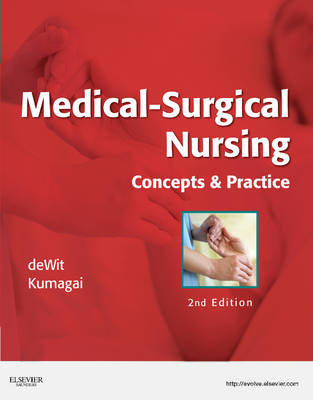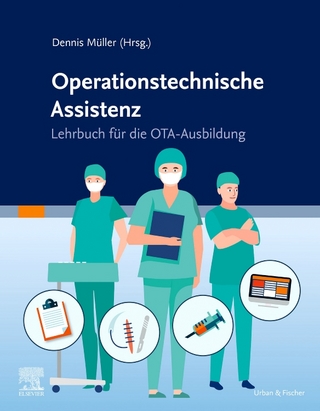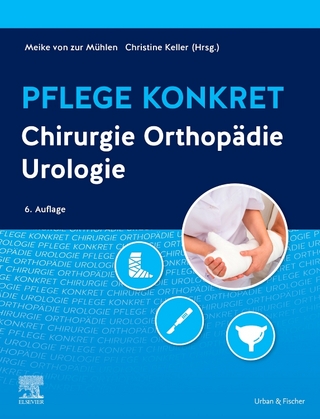
Medical-Surgical Nursing
Saunders (Verlag)
978-1-4377-1707-5 (ISBN)
- Titel erscheint in neuer Auflage
- Artikel merken
The clear, concise, and cutting-edge medical-surgical nursing content in Medical-Surgical Nursing: Concepts & Practice, 2nd Edition provides the solid foundation you need to pass the NCLEX Examination and succeed as a new nurse. It builds on the fundamentals of nursing and covers roles, settings, health care trends, all body systems and their disorders, emergency and disaster management, and mental health nursing. Written by noted authors Susan deWit and Candice Kumagai, Medical-Surgical Nursing reflects current national LPN/LVN standards with its emphasis on safety as well as complementary and alternative therapies.
UNIQUE! LPN Threads share learning features with Elsevier's other LPN textbooks, providing a consistency across the Elsevier LPN curriculum.
Key Terms include phonetic pronunciations and text page references.
Key Points are located at the end of chapters and summarize chapter highlights.
Overview of Anatomy and Physiology at the beginning of each body system chapter provides basic information for understanding the body system and its disorders.
Nursing Process provides a consistent framework for disorders chapters.
Evidence-Based Practice is highlighted with special icons indicating current research.
Assignment Considerations boxes address situations in which the charge nurse delegates to the LPN/LVN or the LPN/LVN assigns tasks to unlicensed assistive personnel.
Focused Assessment boxes include information on history taking and psychosocial assessment, physical assessment, and guidance on how to collect data/information for specific disorders.
Elder Care Points boxes address the unique medical-surgical care issues that affect older adults.
Legal and Ethical Considerations boxes focus on specific disorder-related issues.
Safety Alert boxes highlight specific dangers to patients related to medications and clinical care.
Clinical Cues provide guidance and advice related to the application of nursing care.
Think Critically About boxes encourage you to synthesize information and apply concepts beyond the scope of the chapter.
Concept Maps in the disorders chapters help you visualize difficult material and illustrate how a disorder's multiple symptoms, treatments, and side effects relate to each other.
Health Promotion boxes address wellness and disease prevention, including diet, infection control, and more.
Complementary�and Alternative Therapies boxes offer information on how nontraditional treatments for medical-surgical conditions may be used to complement traditional treatment.
Cultural Considerations promote understanding and sensitivity to various ethnic groups.
Nutrition Considerations address the need for holistic care and reflect the increased focus on nutrition in the NCLEX Examination.
Patient Teaching boxes provide step-by-step instructions and guidelines for post-hospital care.
Home Care Considerations boxes focus on post-discharge adaptations of medical-surgical nursing care to the home environment.
Mental Health Nursing unit includes information on disorders of anxiety and mood, eating disorders, cognitive disorders, thought and personality disorders, and substance abuse.
Disaster Management content includes material focusing on preparation and mitigation to avoid losses and reduce the risk of injury associated with both natural and bioterrorist disasters.
Nursing Care Plans with Critical Thinking Questions show how a care plan is developed and how to evaluate care of a patient.
Review questions for the NCLEX-PN Examination at the end of each chapter include alternate-item format questions and help prepare you for class tests and the NCLEX exam.
Critical Thinking Activities at the end of chapters include clinical situations and relevant questions, allowing you to hone your critical thinking skills.
UNIQUE! Best Practices are highlighted to show the latest evidence-based research related to interventions.
Online resources listed at the end of each chapter promote comprehensive patient care based on current national standards and evidence-based practices.�
UNIQUE! Icons in page margins point to related animations, video clips, additional content, and related resources on the Evolve site.
Unit One: Medical-Surgical Nursing Settings, Roles, and Issues
1. Caring for Medical-Surgical Patients
2. Critical Thinking and Nursing Process
Unit Two: Medical-Surgical Patient Care Problems
3. Fluids, Electrolytes, Acid-Base Balance, and Intravenous Therapy
4. Care of Preoperative and Intraoperative Surgical Patients
5. Care of Postoperative Surgical Patients
6. Infection Prevention and Control
7. Care of Patients with Pain
8. Care of Patients with Cancer
9. Chronic Illness and Rehabilitation
Unit�Three: Immune System
10. The Immune and Lymphatic Systems
11. Care of Patients with HIV/AIDS
12. Care of Patients with Immune and Lymphatic Disorders
Unit�Four: Respiratory System
13. The Respiratory System
14. Care of Patients with Disorders of the Upper Respiratory System
15. Care of Patients with Disorders of the Lower Respiratory System
Unit�Five: Hematologic System
16. The Hematologic System
17. Care of Patients with Hematologic Disorders
Unit�Six: Cardiovascular System
18. The Cardiovascular System
19. Care of Patients with Hypertension and Peripheral Vascular Disease
20. Care of Patients with Cardiac Disorders
21. Care of Patients with Coronary Artery Disease and Cardiac Surgery
Unit�Seven: Neurologic System
22. The Neurologic System
23. Care of Patients with Head and Spinal Cord Injuries
24. Care of Patients with Disorders of the Brain
25. Care of Patients with Degenerative Neurologic Disorders
Unit�Eight: Sensory System
26. The Sensory System: Eye and Ear
27. Care of Patients with Disorders of the Eyes and Ears
Unit�Nine: Gastrointestinal System
28. The Gastrointestinal System
29. Care of Patients with Disorders of the Upper Gastrointestinal System
30. Care of Patients with Disorders of the Lower Gastrointestinal System
31. Care of Patients with Disorders of the Gallbladder, Liver, and Pancreas
Unit�Ten: Musculoskeletal System
32. The Musculoskeletal System
33. Care of Patients with Musculoskeletal and Connective Tissue Disorders
Unit�Eleven: Urinary System
34. The Urinary System
35. Care of Patients with Disorders of the Urinary System
Unit�Twelve: Endocrine System
36. The Endocrine System
37. Care of Patients with Pituitary, Thyroid, Parathyroid, and Adrenal Disorders
38. Care of Patients with Diabetes and Hypoglycemia
Unit�Thirteen: Reproductive System
39. Care of Women with Reproductive Disorders
40. Care of Men with Reproductive Disorders
41. Care of Patients with Sexually Transmitted Infections
Unit�Fourteen: Integumentary System
42. The Integumentary System
43. Care of Patients with Integumentary Disorders and Burns
Unit�Fifteen: Emergency and Disaster Management
44. Care of Patients in Disasters or Bioterrorism Attack
45. Care of Patients with Trauma or Shock
Unit�Sixteen: Mental Health Nursing of the Adult
46. Care of Patients with Anxiety, Mood, and Eating Disorders
47. Care of Patients with Substance Abuse Disorders
48. Care of Patients with Cognitive Disorders
49. Care of Patients with Thought and Personality Disorders
Appendices
Appendix A: Most Common Laboratory Test Values
Appendix B: Standard Precautions
Appendix C: Standard Steps for All Nursing Procedures
Appendix D: Answers to Review Questions for the NCLEX Examination
Bibliography
Illustration Credits
Glossary
Index
| Erscheint lt. Verlag | 30.3.2012 |
|---|---|
| Zusatzinfo | Approx. 350 illustrations (340 in full color) |
| Verlagsort | Philadelphia |
| Sprache | englisch |
| Maße | 222 x 281 mm |
| Themenwelt | Pflege ► Fachpflege ► Chirurgie / OP-Pflege / Orthopädie |
| ISBN-10 | 1-4377-1707-1 / 1437717071 |
| ISBN-13 | 978-1-4377-1707-5 / 9781437717075 |
| Zustand | Neuware |
| Haben Sie eine Frage zum Produkt? |
aus dem Bereich



